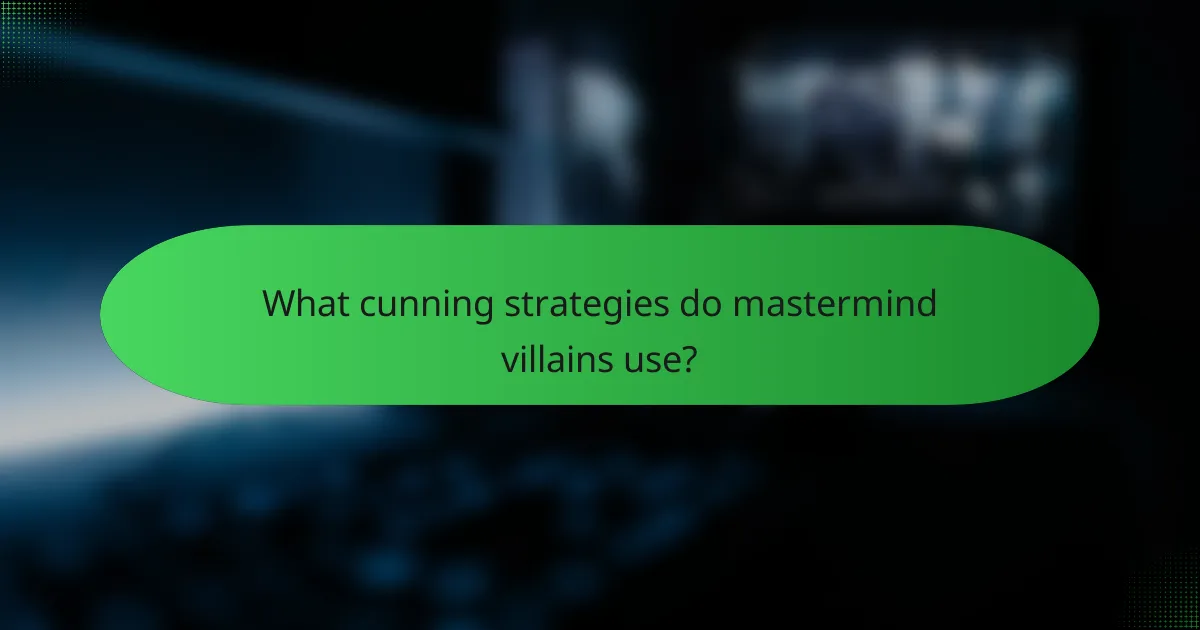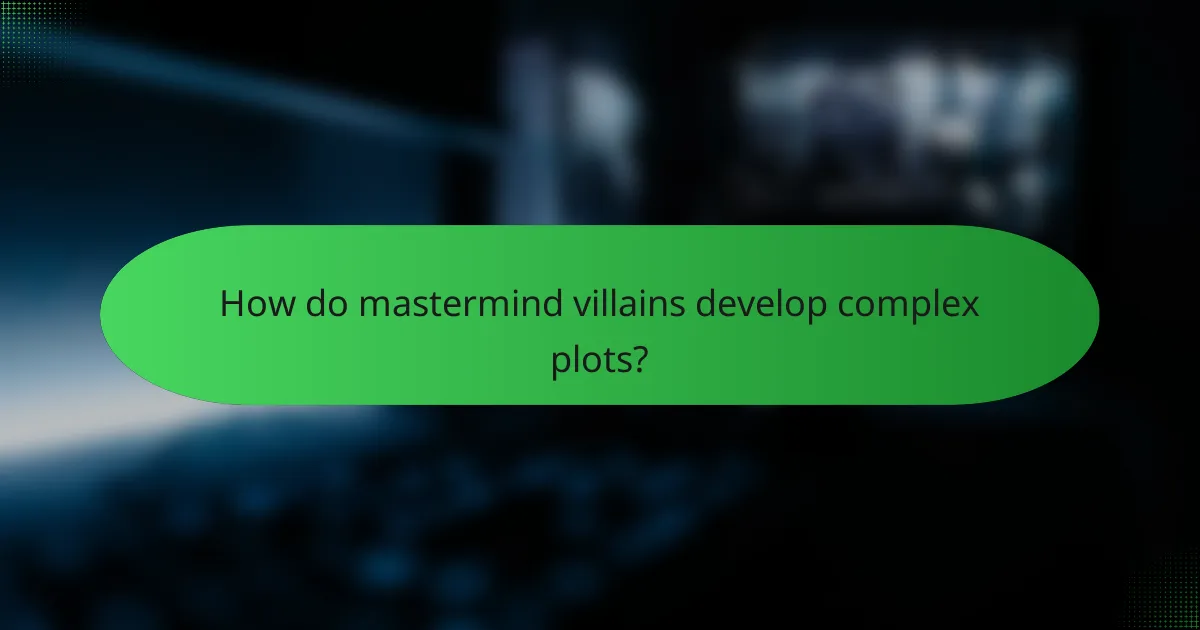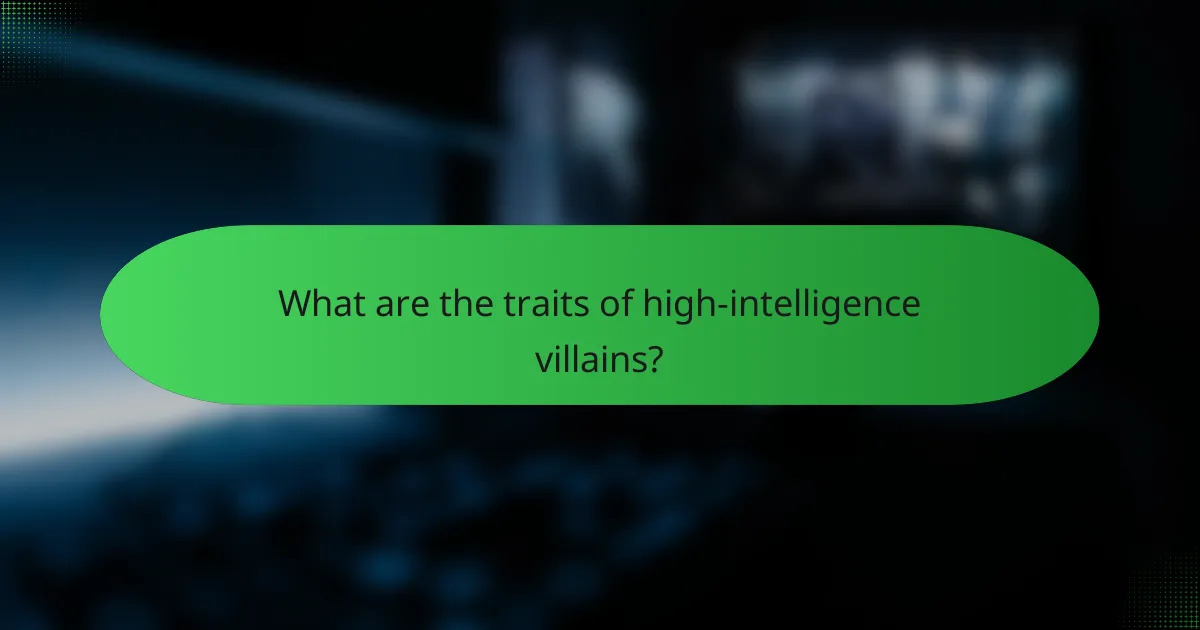Mastermind villains are defined by their high intelligence and cunning strategies, allowing them to manipulate situations and people to achieve their nefarious goals. Through meticulous planning and psychological manipulation, they craft complex plots that captivate audiences and keep them on the edge of their seats. Their exceptional problem-solving skills and resourcefulness make them formidable adversaries, capable of orchestrating elaborate schemes with precision.

What cunning strategies do mastermind villains use?
Mastermind villains employ a variety of cunning strategies to achieve their goals, often relying on psychological manipulation, deception, and the exploitation of others’ weaknesses. These tactics allow them to orchestrate complex plots while maintaining an air of intelligence and control.
Psychological manipulation
Psychological manipulation involves influencing others’ thoughts and behaviors to serve the villain’s agenda. This can include tactics such as gaslighting, where the villain makes others doubt their perceptions, or using charm to gain trust before betraying it. Understanding the emotional triggers of their targets allows villains to exploit vulnerabilities effectively.
For example, a villain might feign sympathy to gain a victim’s confidence, only to later use that trust against them. Recognizing these manipulative behaviors can help individuals protect themselves from falling victim to such tactics.
Deception and misdirection
Deception and misdirection are key strategies for mastermind villains, allowing them to create false narratives that distract from their true intentions. This can involve planting false evidence or creating elaborate stories that lead others to draw incorrect conclusions. The goal is to keep opponents guessing and off-balance.
A common technique is the use of red herrings—clues or distractions that divert attention from the real issue. For instance, a villain might stage a minor crime to draw law enforcement away from their more significant plans, effectively buying time to execute their scheme.
Creating complex alibis
Mastermind villains often craft intricate alibis to avoid suspicion and evade capture. This involves planning their whereabouts and activities meticulously, ensuring they have credible witnesses or evidence to support their claims. A well-constructed alibi can make it extremely difficult for authorities to connect them to a crime.
For instance, a villain might arrange for multiple people to confirm their presence at a different location during a crime. This level of planning requires foresight and attention to detail, making it a hallmark of a cunning strategist.
Exploiting weaknesses
Exploiting weaknesses is a fundamental tactic for mastermind villains, as they often identify and take advantage of the flaws in their adversaries. This can include personal insecurities, professional rivalries, or even legal loopholes. By understanding what drives their targets, villains can manipulate situations to their favor.
For example, a villain might exploit a rival’s fear of failure by spreading rumors that undermine their confidence, ultimately leading to their downfall. Recognizing these weaknesses can help individuals fortify themselves against such attacks.
Building a loyal network
Building a loyal network is crucial for mastermind villains, as it provides them with resources, information, and support. This network often consists of individuals who share similar goals or are manipulated into loyalty through fear or reward. A strong network allows villains to execute their plans more effectively and with greater security.
For instance, a villain might recruit accomplices by offering them a share of the spoils or by leveraging their secrets. Cultivating loyalty ensures that the villain has allies who will protect them and further their schemes, making it essential for long-term success.

How do mastermind villains develop complex plots?
Mastermind villains create complex plots through meticulous planning and strategic layering of narrative elements. They utilize various techniques to weave intricate stories that captivate audiences and keep them guessing.
Layered storytelling
Layered storytelling involves constructing a narrative with multiple levels of meaning and subplots that enhance the main story. This technique allows the villain’s motivations and actions to resonate on different levels, creating a richer experience for the audience.
For example, a villain might have a personal vendetta that intertwines with a larger scheme, revealing deeper emotional stakes as the plot unfolds. This complexity keeps readers engaged and encourages them to piece together the various layers over time.
Intertwined character arcs
Intertwined character arcs are crucial for developing a mastermind villain’s plot. By connecting the villain’s journey with those of other characters, the narrative becomes more dynamic and engaging. Each character’s growth can reflect or contrast with the villain’s actions, adding depth to the story.
For instance, a hero’s struggle against the villain can parallel the villain’s own internal conflicts, creating a compelling duality. This relationship not only drives the plot forward but also allows for character development that enhances the overall narrative.
Unexpected twists
Unexpected twists are a hallmark of complex plots crafted by mastermind villains. These surprises can shift the audience’s perception of characters or events, keeping them on their toes. A well-placed twist can reveal hidden motives or alter the stakes dramatically.
For example, a trusted ally might betray the protagonist, revealing the villain’s influence over them. Such twists not only shock the audience but also reinforce the villain’s cunning nature and strategic foresight.
Foreshadowing key events
Foreshadowing is an essential technique for mastermind villains, as it builds anticipation and tension throughout the plot. By subtly hinting at future events, the villain can create a sense of inevitability that enhances the story’s complexity.
Effective foreshadowing might include seemingly innocuous details that later become significant, such as a character’s offhand remark or a recurring symbol. This technique encourages the audience to engage more deeply with the narrative, as they piece together clues leading to the climax.

What are the traits of high-intelligence villains?
High-intelligence villains are characterized by their sharp intellect, enabling them to devise intricate plans and manipulate situations to their advantage. Key traits include exceptional problem-solving skills, advanced strategic thinking, emotional intelligence, and resourcefulness, which together create a formidable adversary.
Exceptional problem-solving skills
Exceptional problem-solving skills allow high-intelligence villains to navigate complex challenges effectively. They can analyze situations from multiple angles, identifying potential obstacles and devising innovative solutions. For instance, a villain might use misdirection to divert attention while executing a plan, showcasing their ability to think on their feet.
These villains often employ logical reasoning and critical thinking, which helps them anticipate the reactions of others. By understanding human behavior and motivations, they can craft solutions that exploit weaknesses in their opponents.
Advanced strategic thinking
Advanced strategic thinking is crucial for high-intelligence villains, enabling them to create long-term plans that account for various contingencies. They often think several steps ahead, similar to a chess player anticipating their opponent’s moves. This foresight allows them to set traps and manipulate events to ensure their success.
For example, a villain might orchestrate a series of events that appear unrelated but ultimately serve a singular purpose. This complexity can confuse their adversaries, making it difficult for them to counteract the villain’s plans effectively.
Emotional intelligence
Emotional intelligence plays a significant role in the effectiveness of high-intelligence villains. They possess the ability to read and understand the emotions of others, which they use to manipulate people and situations. By tapping into the fears, desires, and motivations of their targets, they can influence decisions and actions in their favor.
For instance, a villain might exploit a rival’s insecurities to create discord within a team, weakening their collective strength. This skill allows them to build alliances or sow distrust, furthering their objectives without direct confrontation.
Resourcefulness
Resourcefulness is a defining trait of high-intelligence villains, enabling them to make the most of limited resources. They can adapt to changing circumstances and find creative solutions to unexpected challenges. This flexibility often gives them an edge over less adaptable opponents.
For example, a villain might utilize everyday items in unconventional ways to achieve their goals, demonstrating their ability to think outside the box. This trait not only enhances their plans but also keeps their adversaries guessing, as they never know what tactics the villain might employ next.
![]()
What are the most iconic mastermind villains in literature and film?
Iconic mastermind villains are characterized by their high intelligence, cunning strategies, and complex plots that often challenge protagonists. Notable examples include Hannibal Lecter and James Moriarty, who exemplify the archetype through their intricate schemes and psychological manipulation.
Hannibal Lecter
Hannibal Lecter, a character created by Thomas Harris, is a brilliant psychiatrist and cannibalistic serial killer. His intelligence allows him to manipulate those around him, often outsmarting law enforcement and his adversaries with ease. Lecter’s psychological insights and strategic thinking make him a formidable foe.
One of Lecter’s most notorious strategies involves playing mind games with his captors, using their weaknesses against them. This manipulation not only showcases his cunning but also highlights the psychological depth of his character. His ability to remain calm and collected under pressure is a key aspect of his villainy.
James Moriarty
James Moriarty, often referred to as Sherlock Holmes’ greatest adversary, is a criminal mastermind whose intellect rivals that of the famous detective. Moriarty’s complex plots often involve elaborate schemes that require meticulous planning and execution, making him a quintessential villain in detective fiction.
Moriarty’s strategies typically include orchestrating criminal activities from the shadows, allowing him to maintain plausible deniability while manipulating events to his advantage. His character embodies the archetype of the mastermind villain, where intelligence and strategy are paramount in outwitting his opponents.
